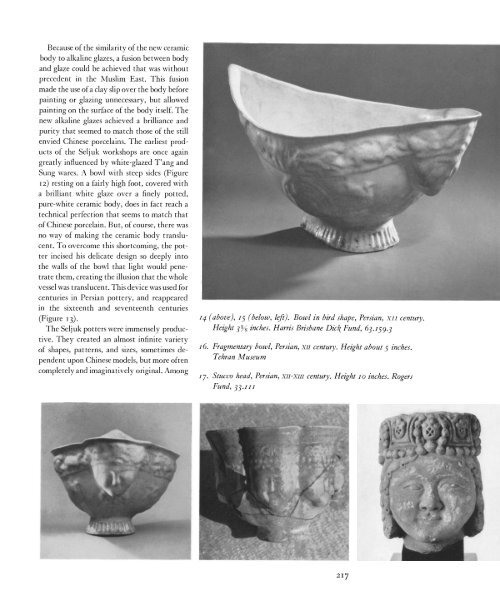Islamic Art: The Metropolitan Museum of Art Bulletin, v. 23, no. 6 ...
Islamic Art: The Metropolitan Museum of Art Bulletin, v. 23, no. 6 ...
Islamic Art: The Metropolitan Museum of Art Bulletin, v. 23, no. 6 ...
Create successful ePaper yourself
Turn your PDF publications into a flip-book with our unique Google optimized e-Paper software.
Because <strong>of</strong> the similarity <strong>of</strong> the new ceramic<br />
body to alkaline glazes, a fusion between body<br />
and glaze could be achieved that was without<br />
precedent in the Muslim East. This fusion<br />
made the use <strong>of</strong> a clay slip over the body before<br />
painting or glazing unnecessary, but allowed<br />
painting on the surface <strong>of</strong> the body itself. <strong>The</strong><br />
new alkaline glazes achieved a brilliance and<br />
purity that seemed to match those <strong>of</strong> the still<br />
envied Chinese porcelains. <strong>The</strong> earliest products<br />
<strong>of</strong> the Seljuk workshops are once again<br />
greatly influenced by white-glazed T'ang and<br />
Sung wares. A bowl with steep sides (Figure<br />
12) resting on a fairly high foot, covered with<br />
a brilliant white glaze over a finely potted,<br />
pure-white ceramic body, does in fact reach a<br />
technical perfection that seems to match that<br />
<strong>of</strong> Chinese porcelain. But, <strong>of</strong> course, there was<br />
<strong>no</strong> way <strong>of</strong> making the ceramic body translucent.<br />
To overcome this shortcoming, the potter<br />
incised his delicate design so deeply into<br />
the walls <strong>of</strong> the bowl that light would penetrate<br />
them, creating the illusion that the whole<br />
vessel was translucent. This device was used for<br />
centuries in Persian pottery, and reappeared<br />
in the sixteenth and seventeenth centuries<br />
(Figure 13).<br />
<strong>The</strong> Seljuk potters were immensely productive.<br />
<strong>The</strong>y created an almost infinite variety<br />
<strong>of</strong> shapes, patterns, and sizes, sometimes dependent<br />
upon Chinese models, but more <strong>of</strong>ten<br />
completely and imaginatively original. Among<br />
14 (above), I5 (below, left). Bowl in bird shape, Persian, XII century.<br />
Height 3s inches. Harris Brisbane Dick Fund, 63.I59.3<br />
I6. Fragmentary bowl, Persian, xII century. Height about 5 inches.<br />
Tehran <strong>Museum</strong><br />
I7. Stucco head, Persian, xII-xm century. Height Io inches. Rogers<br />
Fund, 33. II<br />
217

















